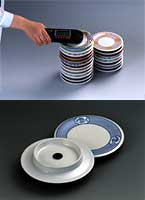|
|
|||||||
|
|
|||||||
|
|||||||
| | Web Japan >>| Trends in Japan >> | Science & Technology >> | Farewell to Barcodes? | |
|
FAREWELL TO BARCODES? IC Tags Set to Revolutionize Shopping (December 24, 2003) Tags that store information using tiny integrated circuits no larger than the size of a sesame seed appear set to revolutionize the way people shop, replacing the familiar bar code. Vast quantities of information transmitted wirelessly from multiple IC tags can be read almost instantly, and these tags are already being used by some businesses. Plates equipped with an IC tag at a conveyor-belt sushi restaurant, for example, allow the restaurant to regulate the freshness of the sushi revolving on the belt and enable each diner's bill to be calculated automatically. Objects where IC tags are likely to appear in the future include ID cards, currency, and all kinds of commercial products. Uses will include verifying a person's identity, preventing counterfeiting, and allowing consumers to safely choose food products. The Ministry of Public Management, Home Affairs, Posts, and Telecommunications forecasts that the economic benefits of IC tags could reach up to ¥31 trillion ($281 billion at ¥110 to the dollar) in 2010.
Better than Bar Codes IC tags can perform many more functions than bar codes. The first major difference is the sheer volume of information they can store. A bar code represents a 13-digit number, so it is limited to 10 trillion possible values (1013). The Mu-chip (named after the twelfth letter of the Greek alphabet) produced by Hitachi, however, which is one of the world's smallest chips at just 0.4 millimeters square - about the thickness of a sheet of paper - can store a 38-digit number, in other words, 10 septillion (1025) times more. A different numerical value can thus be allotted to each of an essentially limitless number of products. And while bar codes are exposed to light and read one at a time, IC tags can be read simultaneously at a rate of 50 per second. In addition, IC tag data can be rewritten or added to. IC tags are already being put to practical use. A chain of kaitenzushi (conveyor-belt sushi) restaurants in the greater Tokyo area called Genki Sushi began using IC tags about a year ago in order to guarantee the freshness of their products. Another chain called Sushi Ondo, where every dish costs ¥100 ($0.91), has introduced a similar system. On the bottom of every plate in these restaurants is a 1-centimeter IC tag encased in resin. Each one of the roughly 2,000 plates in stock has its own number. An antenna near the conveyor belt checks the plates, and when a plate of sushi has been on the belt for 50 minutes, a mechanical arm automatically removes it. A spokesperson for the company explains, "Our shops are becoming larger, so it is essential to have a system of quality control that can be operated by part-timers." Kitanihon-Kakoh, the company that developed this system, has also commercialized a system that allows for bills at a restaurant to be calculated automatically using IC tags. When a reader is held up to the pile of plates left behind by a customer at a kaitenzushi restaurant, the bill can be calculated in about one second. A spokesperson for the company says, "Kaitenzushi restaurants used to offer sushi at only two or three prices per outlet. Now some offer seven or eight different grades of sushi. While it would be easy to make a mistake when calculating the bill manually, getting it done accurately and fast benefits both the customer and the restaurant."
Crime Prevention IC tags can also be used in things like tickets and books. Advance ticket sales for the 2005 World Exposition, Aichi, Japan began on September 25, 2003, and these tickets contain IC tags that will prevent counterfeiting and help organizers to manage admissions. Bookstores, meanwhile, are hoping that IC tags will be an effective method of fighting shoplifting. If a book containing an IC tag were to leave the store without passing through the checkout line, an alarm would sound. Used bookstores, meanwhile, could use these tags to determine whether or not a book they intended to purchase had been shoplifted. Other possible uses of IC tags include storing personal information in passports and ID cards to verify the holder's identity; implanting them into currency and expensive brand goods to prevent counterfeiting; fitting them to credit cards to keep a record of money spent and the current balance; and using them in healthcare to store a patient's medical records and drug prescriptions in order to prevent any mishaps. The use of IC tags is expected to benefit industry in a variety of ways, enabling companies to keep track of inventory and product distribution more efficiently. The government anticipates considerable benefits across the economy. The main hurdle preventing the spread of IC tags at present is the cost - nearly ¥100 ($0.91) per tag. IC tags are sure to make their way into cheaper products once the price comes down. Related Web SitesMinistry of Public Management, Home Affairs, Posts, and Telecommunications Hitachi Genki Sushi (Japanese only) Kitanihon-Kakoh (Japanese only) Ubiquitous ID Center 2005 World Exposition, Aichi, Japan Copyright (c) 2004 Web Japan. Edited by Japan Echo Inc. based on domestic Japanese news sources. Articles presented here are offered for reference purposes and do not necessarily represent the policy or views of the Japanese Government. |
TOWARD A TICKETLESS STATION (January 8, 2002) SUSHI GOES HI-TECH (November 26, 2001) IT'S A CAMERA, A STEREO, AND A TRAIN TICKET (February 7, 2001) |
|
|



